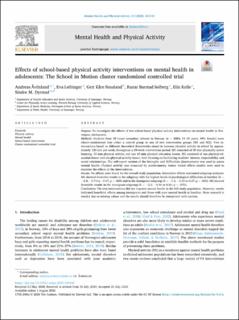| dc.contributor.author | Åvitsland, Andreas | |
| dc.contributor.author | Leibinger, Eva | |
| dc.contributor.author | Resaland, Geir Kåre | |
| dc.contributor.author | Solberg, Runar Barstad | |
| dc.contributor.author | Kolle, Elin | |
| dc.contributor.author | Dyrstad, Sindre Mikal | |
| dc.date.accessioned | 2021-01-26T23:20:57Z | |
| dc.date.available | 2021-01-26T23:20:57Z | |
| dc.date.created | 2020-08-03T10:27:06Z | |
| dc.date.issued | 2020 | |
| dc.identifier.citation | Mental Health and Physical Activity. 2020, 19(Oktober 2020), Artikkel 100348. | en_US |
| dc.identifier.issn | 1755-2966 | |
| dc.identifier.uri | https://hdl.handle.net/11250/2724870 | |
| dc.description | This is an open access article under the CC BY license (http://creativecommons.org/licenses/by/4.0/). | en_US |
| dc.description.abstract | Purpose: To investigate the effects of two school-based physical activity interventions on mental health in Norwegian adolescents.
Methods: Students from 29 lower secondary schools in Norway (n = 2084; 14–15 years; 49% female) were cluster-randomized into either a control group or one of two intervention groups (M1 and M2). Two interventions based on different theoretical frameworks aimed to increase physical activity in school by approximately 120 min per week, throughout a 29-week intervention period. M1 consisted of 30 min physically active learning, 30 min physical activity and one 60 min physical education lesson. M2 consisted of one physical education lesson and one physical activity lesson, both focusing on facilitating students’ interest, responsibility and social relationships. The self-report version of the Strengths and Difficulties Questionnaire was used to assess mental health. Physical activity was measured by accelerometry. Linear mixed effects models were used to examine the effects of the interventions.
Results: No effects were found for the overall study population. Interaction effects warranted subgroup analyses: M1 showed favorable results in the subgroup with the highest levels of psychological difficulties at baseline (b = −2.9; −5.73 to −0.07; p = .045) and in the immigrant subgroup (b = −1.6; −3.53 to 0.27; p = .093). M2 showed favorable results in the immigrant subgroup (b = −2.1; −4.36 to 0.21; p = .075).
Conclusions: The two interventions did not improve mental health in the full study population. However, results indicated beneficial effects among immigrants and those with poor mental health at baseline. More research is needed due to missing values and the results should therefore be interpreted with caution. | en_US |
| dc.language.iso | eng | en_US |
| dc.subject | physical activity | en_US |
| dc.subject | mental health | en_US |
| dc.subject | school-based intervention | en_US |
| dc.subject | cluster randomized controlled trial | en_US |
| dc.title | Effects of school-based physical activity interventions on mental health in adolescents: The School in Motion cluster randomized controlled trial | en_US |
| dc.type | Peer reviewed | en_US |
| dc.type | Journal article | en_US |
| dc.description.version | publishedVersion | en_US |
| dc.rights.holder | © 2020 The Authors | en_US |
| dc.source.pagenumber | 10 | en_US |
| dc.source.volume | 19 | en_US |
| dc.source.journal | Mental Health and Physical Activity | en_US |
| dc.identifier.doi | 10.1016/j.mhpa.2020.100348 | |
| dc.identifier.cristin | 1821255 | |
| dc.description.localcode | Institutt for idrettsmedisinske fag / Department of Sports Medicine | en_US |
| dc.source.articlenumber | 100348 | en_US |
| cristin.ispublished | true | |
| cristin.fulltext | original | |
| cristin.qualitycode | 1 | |
